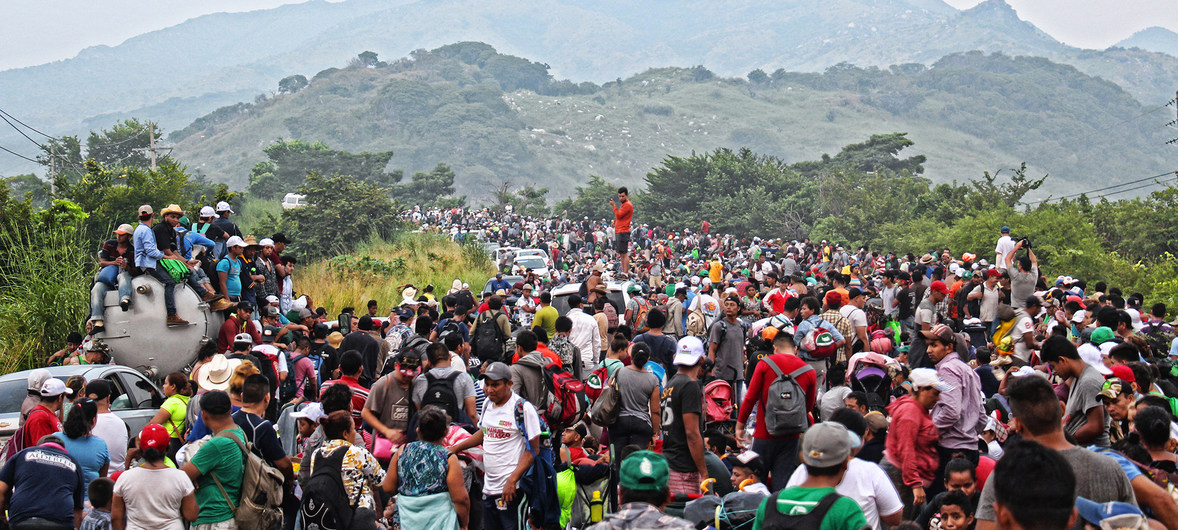
Recent headlines from Central America shed light on the migrant exodus from the isthmus that has now sparked a political crisis in the United States. The ongoing protests against neoliberal “reform” in Honduras saw a frightening escalation June 25 as military police opened fire on students demonstrators at the National Autonomous University in Tegucigalpa, injuring at least four. President Juan Orlando Hernández has deployed the army and military police across the country after clashes left three dead last week. (BBC News, La Prensa, June 25) In a hopeful sign a few days earlier, riot police stood down in Tegucigalpa, returning to their barracks and allowing protesters to block traffic and occupy main streets. Troops of the National Directorate of Special Forces said they will not carry out anti-riot operations if they do not receive better benefits. (Reuters, June 19)
On World Environment Day, June 5, some 16,000 people in San Salvador took to the streets for the 19th annual Caminata Ecológica (Ecological Walk), calling for land and water rights and an end to the government’s water privatization policies. This annual urban pilgrimage began in 2000 and traditionally ends at the presidential residence, where a letter is delivered outlining demands. This year, however, the Caminata was stopped several blocks short of its destination by riot police and barbed-wire barricades, preventing marchers from delivering the letter. Demands included approval of a General Water Law that would guarantee the right to water and community control of water management. The Caminata also called for urgent attention to contamination of the Río Lempa by mining projects in neighboring Guatemala and Honduras that impact the cross-border basin (CISPES, June 14)
We’ve noted before the roots of the current massive migration from Central America in the political economy of the free trade order. The US-led repression and counter-insurgency in the isthmus in the 1980s allowed the imposition of “free trade” or “neoliberal” regimes in the generation since then—ultimately culminating in the passage of CAFTA. This, in turn, has exacerbated the expropriation from the peasantry of their traditional lands by agribusiness and agro-export oligarchies. But this dynamic is now being augmented by factors related to political ecology—the degradation of the land itself due to climate destabilization.
Both these factors were touched upon in a Public Radio International report on April 24:
The decline of El Salvador’s coffee industry goes back decades and is the result of a lot of problems: the low price of coffee on the market, lack of investment in the farms and agricultural pests. But farmers, agricultural experts and environmental academics also point to another factor compounding the challenges: climate change.
Coffee exports, once the backbone of El Salvador’s economy, have fallen by more than half in the last 10 years, according to the Salvadoran Coffee Council. And as production has plummeted, work has dried up. El Salvador’s coffee industry has lost more than 80,000 jobs over the same period, contributing to the wave of migration north.
Nearly 20% of the population of this tiny Central American country now lives in the US.
Paul Hicks of Catholic Relief Services is quoted: “In past decades, you had hundreds of thousands of people working on coffee farms to harvest coffee and to process it. Because of the low production and low investment in coffee, a lot of those farm workers are choosing to migrate to earn seasonal income rather than to work on coffee farms.”
In addition to factors related to corporate globalization, coffee production is being hit hard by a long drought and the effects of La Roya, or coffee leaf rust. A PBS News Hour notes that these last two factors are also related, as La Roya thrives in hot arid arid conditions.
The World Bank estimates that climate change could displace somewhere between a million and a half to nearly 4 million people in Mexico and Central America over the next 30 years. This reality of somewhat obscured by the facts that the United Nations does not label those forced to migrate due to climate change as “climate refugees.” A change in language would require an agreement among member-states expanding the definition of a refugees—currently defined as “someone who has been forced to flee his or her country because of persecution, war or violence.” (IPS, June 12)
The expropriation of the peasantry under the free-trade order has also sent the dispossessed of Central America into urban slums and the rainforests within the isthmus. Colonization of the eastern rainforests by displaced peasants has been encouraged by successive governments as a kind of social safety valve. This has, of course, resulted in devastation of these forests—itself fueling climate change regionally and globally.
President Donald Trump’s decision to cut hundreds of millions of dollars in aid to El Salvador, Guatemala and Honduras for their supposed failure to halt migration to the north is only likely to deepen the social pressures and contradictions in the isthmus—contributing further to misery, displacement and, ultimately, migration. (Reuters, June 17)
Photo: IOM




